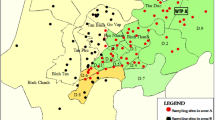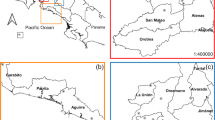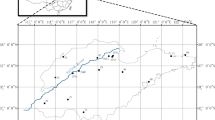Abstract
Organic matters in raw water have a potential to generate harmful disinfection byproducts such as trihalomethanes (THMs) and haloacetic acid (HAA) during the chlorination process. The aim of this study was to investigate the trihalomethane formation potential (THMFP) and haloacetic acid formation potential (HAAFP) in Melendiz River and to determine the effect of several factors including water quality parameters, distance, and seasonal variation. Water samples (n = 93) were collected at Melendiz River during December 2015–November 2016. The range of THMFP and HAAFP was 47.28–3348.73 μg/L and 41.42–4952.68 μg/L, respectively. ANOVA analysis was performed to understand the impact of the seasonal and/or distance changes on DBPs formation. It was found that the seasonal variations (sig. ≤ 0.01) are more effective than distance variations (sig. > 0.80) at Melendiz River. Finally, a non-linear statistical model was developed based on Multiple Stepwise Regression Analysis using highly correlated water quality parameters with TTHM and THAA5 in Pearson Correlation Analysis. According to the results, among all factors, flow, dissolved organic carbon (DOC), UV254, UV272, bromide, temperature, and additional chlorine dose have a remarkable effect on THMFP and HAAFP. Especially, the Pearson correlation (P) values for the DOC and the Chlorine dosages are 0.583, 0.786 and 0.994 and 0.865 for THMFP and HAAFP models, respectively. In addition to this, the high R2 (0.95) values were obtained when compared to other predictive models. The local model development should be utilized because each water source has different organic characterization. For this reason, the development of local models for each water source is important for achieving more consistent results.



Similar content being viewed by others
References
Akbarzadeh S, Kafaei R, Hashemi S, Ramavandi B (2016) Data on the relationship between bromide content and the formation potential of THMs, HAAs, and HANs upon chlorination and monochloramination of Karoon River water, Iran. Data Brief 8:415–419
Alexandrou L, Meehan BJ, Jones OA (2018) Regulated and emerging disinfection by-products in recycled waters. Sci Total Environ 637:1607–1616
Alver A, Karaarslan M, Kılıç A (2016) The catalytic activity of the iron-coated pumice particles used as heterogeneous catalysts in the oxidation of NOM by H2O2. Environ Technol 37(16):2040–2047
American Public Health Association AWWA, Water Environment Federation (2012) Standard methods for the examination of water and wastewater, vol 22. American Public Health Association AWWA, Water Environment Federation, Washington
Amy G, Siddiqui M, Ozekin K, Zhu H W, Wang C (1998) Empirically based models for predicting chlorination and ozonation by-products: haloacetic acids, chloral hydrate, and bromate EPA. Report CX 819579, National Service Center for Environmental Publications (NSCEP)
Association APH, Association AWW, Federation WPC, Federation WE (1915) Standard methods for the examination of water and wastewater, vol 2. American Public Health Association, Washington
Avşar E, Toröz İ (2018) Seasonal determination and investigation of disinfection by product formatıon potentials (DBPFP) of surface waters, İstanbul Ömerli and Büyükçekmece case study. Anadolu Univ J Sci Technol B- Theor Sci 6(1):22–35
Awad J, van Leeuwen J, Chow C, Drikas M, Smernik R (2015) Modelling THM formation potential based on the character of organics-in catchments and drinking water sources. In: Conference paper 21st international congress on modelling and simulation (MODSIM). The modelling and simulation society of Australia and New Zealand
Awad J, van Leeuwen J, Liffner J, Chow C, Drikas M (2016) Treatability of organic matter derived from surface and subsurface waters of drinking water catchments. Chemosphere 144:1193–1200
Baytak D, Sofuoglu A, Inal F, Sofuoglu SC (2008) Seasonal variation in drinking water concentrations of disinfection by-products in IZMIR and associated human health risks. Sci Total Environ 407:286–296
Bhatnagar A, Sillanpää M (2017) Removal of natural organic matter (NOM) and its constituents from water by adsorption—a review. Chemosphere 166:497–510
Bond T, Henriet O, Goslan E, Parsons S, Jefferson B (2009) Disinfection byproduct formation and fractionation behavior of natural organic matter surrogates. Environ Sci Technol 43:5982–5989
Chhipi-Shrestha G, Rodriguez M, Sadiq R (2018) Unregulated disinfection By-products in drinking water in Quebec: a meta analysis. J Environ Manag 223:984–1000
Chi-Wang L, Korshin GV, Benjamin MM (1998) Monitoring DBP formation with differential UV spectroscopy. Am Water Works Assoc J 90:88
Chowdhury S, Champagne P (2008) An investigation on parameters for modeling THMs formation. Glob Nest J 10:80–91
Chowdhury S, Champagne P, McLellan PJ (2009) Models for predicting disinfection byproduct (DBP) formation in drinking waters: a chronological review. Sci Total Environ 407:4189–4206
Clark RM, Boutin BK (2001) Controlling disinfection by-products and microbial contaminants in drinking water. National Risk Management Research Laboratory, Office of Research and Development, US Environmental Protection Agency, New York
Deborde M, Von Gunten U (2008) Reactions of chlorine with inorganic and organic compounds during water treatment—kinetics and mechanisms: a critical review. Water Res 42:13–51
Deeudomwongsa P, Phattarapattamawong S, Lin K-YA (2017) Control of disinfection byproducts (DBPs) by ozonation and peroxone process: role of chloride on removal of DBP precursors. Chemosphere 184:1215–1222
Domino M, Pepich B, Munch D, Fair P, Xie Y (2003) Method 552.3 determination of haloacetic acids and dalapon in drinking water by liquid–liquid microextraction, derivatization, and gas chromatography with electron capture detection methods for the determination of organic compounds in drinking water. US Environmental Protection Agency, Washington, DC
Edzwald JK, Becker WC, Wattier KL (1985) Surrogate parameters for monitoring organic matter and THM precursors. J Am Water Work Assoc 77(4):122–132
Fooladvand M, Ramavandi B, Zandi K, Ardestani M (2011) Investigation of trihalomethanes formation potential in Karoon River water. Iran Environ Monit Assess 178:63–71
Garvey EA, Tobiason JE (2003) Relationships between measures of NOM in Quabbin Watershed. J Am Water Works Assoc 95:73–84
Golea D, Upton A, Jarvis P, Moore G, Sutherland S, Parsons S, Judd S (2017) THM and HAA formation from NOM in raw and treated surface waters. Water Res 112:226–235
Gough R, Holliman PJ, Willis N, Freeman C (2014) Dissolved organic carbon and trihalomethane precursor removal at a UK upland water treatment works. Sci Total Environ 468:228–239
Hautman DP, Munch DJ (1997) Development of US EPA method 551.1. J Chromatogr Sci 35:221–231
Hodgeson J, Collins J, Barth R (1990) Determinatıon of haloacetic acids in drinking water by liquid liquid extraction, derivatization, and gas chromatography with electron capture detection. In: Environmental monitoring systems laboratory office of research and development, method 552. US Environmental Protection Agency, Cincinnati, Ohio
Hong H, Liang Y, Han B, Mazumder A, Wong M (2007) Modeling of trihalomethane (THM) formation via chlorination of the water from Dongjiang River (source water for Hong Kong’s drinking water). Sci Total Environ 385:48–54
Hua G, Reckhow DA, Abusallout I (2015) Correlation between SUVA and DBP formation during chlorination and chloramination of NOM fractions from different sources. Chemosphere 130:82–89
Ireland E (2012) EPA drinking water guidance on disinfection by-products. Advice note no 4, version 2. Disinfection by-products in drinking water. Environmental Protection Agency, Office of Environmental Enforcement
Li A, Zhao X, Mao R, Liu H, Qu J (2014) Characterization of dissolved organic matter from surface waters with low to high dissolved organic carbon and the related disinfection byproduct formation potential. J Hazard Mater 271:228–235
Liu S, Zhu Z, Fan C, Qiu Y, Zhao J (2011) Seasonal variation effects on the formation of trihalomethane during chlorination of water from Yangtze River and associated cancer risk assessment. J Environ Sci 23:1503–1511
Mayer BK, Ryan DR (2017) Impact on disinfection byproducts using advanced oxidation processes for drinking water treatment. Applications of advanced oxidation processes (AOPs) in drinking water treatment, pp 345–386
Özdemir K, Toröz İ, Uyak V (2013) Assessment of trihalomethane formation in chlorinated raw waters with differential UV spectroscopy approach. Sci World J. https://doi.org/10.1155/2013/890854
Qi W, Zhang H, Hu C, Liu H, Qu J (2018) Effect of ozonation on the characteristics of effluent organic matter fractions and subsequent associations with disinfection by-products formation. Sci Total Environ 610:1057–1064
Ramavandi B, Dobaradaran S, Asgari G, Masoumbeigi H (2013) High potential for the formation of haloacetic acids in the Karoon River water in Iran. Environ Monit Assess 185:3711–3720
Rivadeneyra A, García-Ruiz MJ, Delgado-Ramos F, González-Martínez A, Osorio F, Rabaza O (2014) Feasibility study of a simple and low-cost device for monitoring trihalomethanes presence in water supply systems based on statistical models. Water 6:3590–3602
Rizzo L, Belgiorno V, Gallo M, Meric S (2005) Removal of THM precursors from a high-alkaline surface water by enhanced coagulation and behaviour of THMFP toxicity on D. magna. Desalination 176:177–188
Sadiq R, Rodriguez M (2011) Empirical models to predict disinfection by-products (DBPs) in drinking water. In: Encyclopedia of environmental health, pp 282–295
Shorney HL (1999) Removal of DBP precursors by enhanced coagulation and lime softening. American Water Works Association, Denver
Summers RS, Hooper SM, Shukairy HM, Solarik G, Owen D (1996) Assessing DBP yield: uniform formation conditions. Am Water Works Assoc J 88:80
Świetlik J, Dąbrowska A, Raczyk-Stanisławiak U, Nawrocki J (2004) Reactivity of natural organic matter fractions with chlorine dioxide and ozone. Water Res 38:547–558
TSI (2012) Environment and energy. Environment statistics. Turkish Statistical Institute, Ankara, Turkey
Uyak V, Ozdemir K, Toroz I (2007) Multiple linear regression modeling of disinfection by-products formation in Istanbul drinking water reservoirs. Sci Total Environ 378:269–280
Wei Q, Wang D, Wei Q, Qiao C, Shi B, Tang H (2008) Size and resin fractionations of dissolved organic matter and trihalomethane precursors from four typical source waters in China. Environ Monit Assess 141:347–357
White DM, Garland DS, Narr J, Woolard CR (2003) Natural organic matter and DBP formation potential in Alaskan water supplies. Water Res 37:939–947
Xie Y (2016) Disinfection byproducts in drinking water: Formation, analysis, and control. CRC Press, Boca Raton
Zhu H (1995) Modeling the effects of coagulation on chlorination by-product formation. University of Colorado. PhD thesis
Acknowledgements
We would like to thank the Environmental Engineering Department of Aksaray University for funding this paper and the Aksaray Municipality for helping to gather the samples in the field work. Thanks are due to a range of people who gave advice, offered comments or help in other ways during this paper.
Author information
Authors and Affiliations
Corresponding author
Rights and permissions
About this article
Cite this article
Alver, A., Baştürk, E. & Kılıç, A. Disinfection By-Products Formation Potential Along the Melendiz River, Turkey; Associated Water Quality Parameters and Non-Linear Prediction Model. Int J Environ Res 12, 909–919 (2018). https://doi.org/10.1007/s41742-018-0145-4
Received:
Revised:
Accepted:
Published:
Issue Date:
DOI: https://doi.org/10.1007/s41742-018-0145-4




